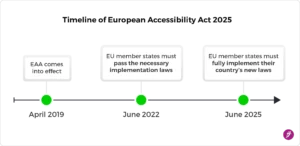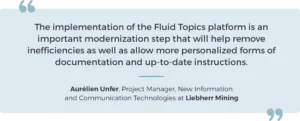The role of technical documentation and content teams has massively shifted in recent years with the emergence of AI tools, docs as code, API-driven approaches, and more. Now, as we launch into 2025, several new trends will continue to reshape how technical documentation is created, shared, and accessed. Read on to dive into the upcoming top 5 technical documentation trends and the technologies and policies driving them.
1. Generative AI Implementation Will Move from “Nice-to-Have“ to “Must-Have”
While AI isn’t a new trend, this technology continues to develop across use cases. The early adopters have come and gone and now, AI applications are mainstream with just 24% of businesses remaining that haven’t adopted AI technology at all.
For technical documentation operations, AI’s potential impact is massive. When implemented throughout the content workflow, Generative AI (GenAI) offers several applications:
- Automating the authoring process: Subject matter experts can leverage AI-powered tools to draft content, which technical writers can subsequently review, rework, and incorporate into the documentation.
- Maintaining consistency across versions and sources: AI optimization tools review documentation and flag inconsistencies to help teams improve and harmonize their writing.
- Enabling autonomous onboarding: With AI-powered chatbots, new hires can ask questions and quickly get succinct, relevant answers in a conversational way without taking away valuable time from their colleagues.
- Improving content experience: With AI applications such as on-the-fly translation and text summarizing, companies can design low-cost solutions that accurately answer user queries quickly with unique customization and personalization options.
Mounting Pressure for Generative AI Applications
Pressure to move faster on GenAI implementation projects is coming from all angles. In an interview, Salesforce CIO Juan Perez speaks to this urgency stating “The explosion of AI has really put CIOs in the spotlight and placed the CIOs in the hot seat like never before. … CIOs and other tech executives from all kinds of organizations are being challenged as to how they can to move quicker, but also responsibly, with AI.”
However, while the pressure rises, projects remain stagnant as 95% of IT leaders report that integration issues impede their AI adoption. Despite barriers to AI implementation, companies continue to envision this technology as a catalyst for change, giving them an edge over the competition. In fact, across company divisions, 71% of leaders expect GenAI’s impact to be medium to significant.
Need for Consolidated Knowledge
In 2025, a key AI application for companies will be chatbots designed to deliver instant, relevant assistance to both internal and external users seeking information. These AI chatbots often leverage Retrieval Augmented Generation (RAG) technology to generate precise responses using the company’s proprietary documentation.
For any GenAI application to work effectively, it must have the ability to access relevant and comprehensive content. Without a centralized and unified hub that consolidates all the necessary information, technologies like RAG cannot operate efficiently. The system relies on having all the data it needs in one place to generate accurate, contextually relevant responses. However, 72% of managers report having no plan or no idea if there is a plan to consolidate information silos into one trusted hub of knowledge content. Additionally, one study found that 92% of respondents reported issues with unstructured data which directly impacted their ability to implement GenAI initiatives. As organizations embark on these new initiatives, they will come to appreciate the importance of having content professionals lead the consolidation process and continue driving content architecture efforts.
One of the best ways to unify content and seamlessly integrate AI content experiences is with an Enterprise Knowledge Platform (EKP).
2. Security and Content Governance Will Become More Important Than Ever
Security considerations exist across teams and are always changing, from evolving industry regulations to integrating new applications and adding content channels. The continued rise of AI and new regulations make 2025 a particularly big year for security. Companies must address challenges such as inadequate access controls, poor version management, and inconsistent security measures, which can make documentation vulnerable to data breaches and unauthorized access to sensitive or confidential information.
User Access and Metadata
To protect data while digitizing content or integrating innovative tools like AI, technical documentation teams need platforms with advanced access controls. With metadata, teams classify content based on different values. With platforms that integrate metadata management, they can configure content permissions based on roles, profiles, group, or even accreditations. These approvals ensure only authorized users have access to sensitive content based on metadata values.
Protecting Confidential Content from RAG
Managing security concerns around AI integration merits its own section as this issue is crucial to helping companies get AI applications up and running. A Cisco study found that 90% of privacy and security professionals agree organizations need updated techniques to manage GenAI risks, while 27% of companies outright banned the use of GenAI until the risks are resolved.
2024 may have brought new concerns, but 2025 will lead with solutions around how to mitigate risks without falling behind competitors with the latest AI tools. While security concerns around RAG systems causing confidential data leaks and misinformation are valid, a clear solution exists. Companies will turn towards solutions like EKPs to offer a secure-by-design AI gateway and natively govern internal content within its infrastructure. As organizations adopt these platforms, IT managers will rest assured their data is protected and technical documentation teams will have the tools needed to provide engaging content experiences.
In addition to the content access rights management, secure EKPs offer two security solutions to mitigate risk:
- Internal Embeddings Management: They integrate the computation of embedding and the vector database within their platform rather than processing it externally. This ensures all content is handled within the platform and the substance of the content remains hidden from the external LLM to prevent information leaks.
- Choice of LLM: They permit companies to select the LLM whose level of security and data protection align with their needs. The chosen LLM is how organizations will access Natural Language Processing in GenAI applications.
3. Document Accessibility Will Reach New Milestones
In the new year, accessibility will move from a buzzword to a real standard that European companies must attain. The European Accessibility Act 2025 (EAA) is a new regulation mandating how businesses based in or selling to the EU must engage with users and customers. This legislation joins the existing Americans with Disabilities act (ADA) in seeking to make the world a more accessible place. While ADA is an all-encompassing framework in the United States, EAA focuses specifically on replacing the previously divergent rules across EU member states which created barriers to trade and market access. EAA also explicitly outlines clear and comprehensive directives around access to digital products and services.
Specifically for technical documentation, the EEA’s new digital content guidelines are based on the Website Content Accessibility Guidelines (WCAG), globally accepted standards for online compliance. These directives include several elements that impact how companies will deliver digital content to users.
- Companies must design user interfaces that are clear and easy to navigate.
- Businesses must provide text alternatives, like captions, for visual media.
- Organizations must allow sufficient time for users to interact with time-sensitive content.
- Companies must publish an accessibility statement with information about the functionality of their products or services, the technical accessibility specifications, how they meet the EAA’s requirements, and more.
EAA is an important standard for ensuring all people have equitable access to learning, employment, and participation in society. This is a meaningful new regulation given the WHO estimates that 1.3 billion people — or 16% of the world’s population — experience significant disability.
4. Paper-heavy Industries Will Make the Switch to Digital
Bringing further change in 2025, the new EU Machinery Directive 2023/1230 replaced the previous Directive 2006/42/EC. This new regulation specifies that organizations may provide machine instructions in a digital format given they fulfill the following requirements:
- They identify how to access the digital instructions directly on the machinery, for example via QR code.
- They deliver the instructions in a format that users can print and download to any digital device. This requirement also applies to contextual help instructions embedded in machinery interfaces.
- They render the instructions available online throughout the machinery’s lifetime and for a minimum of 10 years following the market release.
With this new directive, the European Commission addresses the need to cut back on printed operating manuals. For technical documentation teams, this is great news! Printed documentation doesn’t offer the best accessibility or findability for on-site technicians, nor does it guarantee against content obsolescence. While going digital, the most modern businesses will also invest in Enterprise Knowledge Platforms with advanced search engines to deliver contextual and personalized product information to users anywhere, anytime.
Companies that have already started replacing printed operating manuals with digital ones are reaping the benefits. In addition to reducing printing costs, companies like Liebherr Mining report an enhanced self-service experience for their teams after going digital, as Liebherr achieved this by partnering with Fluid Topics to provide a centralized hub of responsive documentation accessible via any device.
5. Multimedia Documentation Will Overtake Text-Only Docs
In our 2024 technical documentation trends we wrote about the shift “From Text to Rich Media”. This trend will continue to get stronger this year, particularly given the new regulations that will move machinery instructions, including detailed machine schemas, to a digital format.
Responsive Content Will Be Compulsory
The most engaging and user-friendly documentation includes videos, schematic diagrams, and other images to help visual learners best navigate different products. As companies publish an increasing amount of documentation digitally, responsiveness for multimedia content becomes especially important. All kinds of users need access to documentation from different devices whether it be a mobile phone, tablet, laptop, or even AR goggles. In field services, this becomes even more important as 99.5% of field technicians use mobile devices on the job. Yet, they often face inconsistent experiences across devices when trying to access different media formats. Poor responsiveness delays interventions leading to user frustration, product downtimes, and potential safety hazards. In 2025, all users need to be able to access content in any format, from any device, for every product.
Note: In line with 2025 EAA regulations, companies must provide captions for all pre-recorded audio content in synchronized media (e.g. videos with voiceovers or people speaking).
User Generated Content Will Supplement Documentation
Technical writers prepare everything users theoretically need to know about a product, but hands-on practice provides users with the skills, tricks, and workarounds needed to perform tasks faster and more efficiently. Companies rarely take advantage of the wealth of knowledge their users have accumulated despite the critical role it could play in knowledge retention and sharing. In 2025, capturing tacit knowledge will be critical, providing a competitive advantage to companies that succeed. Otherwise, this knowledge will remain in the heads of users where it cannot be of use to others.
By providing a forum-like community where users can share and reuse knowledge, companies can take advantage of this huge opportunity for user engagement and enablement. This User-Generated Content (UGC) may be in any format: text annotations, on-site videos, images, voice notes, etc. Access to real-life context will take documentation to the next level. However, it will also require new QA processes from technical writers to ensure consistency between their original documentation and these additions.
As an emerging trend that is not yet largely practiced, Fluid Topics will continue to monitor and share best practices for creating digital workplaces where users can share UGC. Stay tuned for updates as the year goes on!
Final Thoughts on 2025 Technical Documentation Trends
As technology evolves and new regulations emerge, technical documentation will enter a new phase leading to optimized user access to and sharing of information through various tools and means. Amidst these trends, let’s not forget ongoing trends that remain prevalent, particularly the importance of personalized and contextualized user experiences. New trends continue to push personalization to the front lines. For example, 73% of users expect better personalization following the emergence of Generative AI applications.
Leveraging the trends outlined above will help technical documentation teams empower users and address existing documentation challenges.
Let’s meet back at the end of 2025 to evaluate how these trends have impacted your workflows and metrics throughout the year.
Latest post










